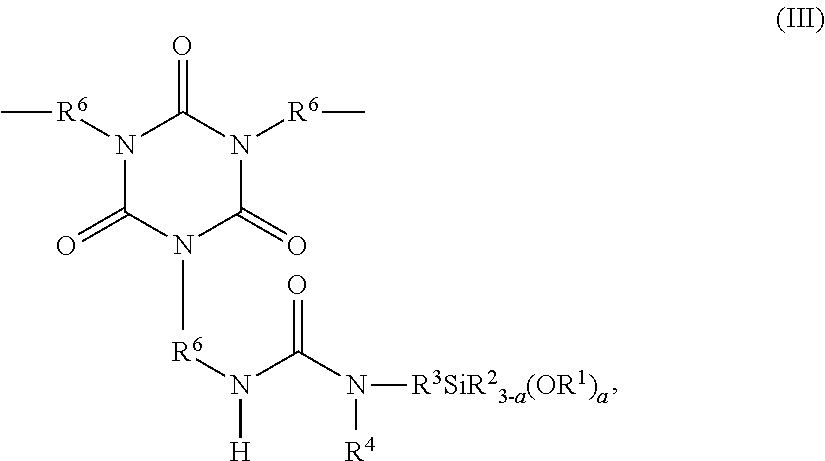Resin compositions and methods of production
- Summary
- Abstract
- Description
- Claims
- Application Information
AI Technical Summary
Benefits of technology
Problems solved by technology
Method used
Image
Examples
example 1
of Moisture-Curable Silylated Polycarbonate Resin A
[0204]Into a 500 mL round bottom flask equipped with a mechanical stirrer, dropping funnel, reflux condenser and nitrogen line, were charged polycarbonate diol A (a hydroxyl-terminated polycarbonate containing 45 mole percent 1,6-hexyl groups and 55 mole percent 1,5-pentyl groups, hydroxyl number of 56, equivalent weight of 1001.5 grams / mole, 124.31 grams, 0.0621 mol) and Solvesso 100 aromatic solvent (52 grams, obtained from ExxonMobil). The mixture was stirred under nitrogen and heated to 90° C. A mixture of isophorone diisocyanate (31.17 grams, 0.1402 mole) and isophorone diisocyanate trimer in butyl acetate (80.29 grams, 0.084 mol, obtained from Vencore X Chemical under the tradename Tolonate™ IDT 70B) were added and reacted at 90° C. for 2.5 hours. An FTIR spectrum of the reaction mixture did not detect any residual hydroxyl groups. The viscosity of the intermediate was 10.2 Pascal-second. N-ethyl-3-amino-2-methylpropyltrimetho...
example 2
tion of Hansen Solubility Parameter for Silylated Resin A
[0205]The Hansen solubility parameters were determined for Silylated Resin A. Into 100 grams of Silylated Resin A, prepared in Example 1, were added 33 grams of solvent. The solvents and their Hansen solubility parameters is given in Table A. The mixture was equilibrated overnight at about 25° C. and then the visual compatibility was determined.
[0206]Each combination of solvent and Silylated Resin A was rated as either “Good” or 1, which indicated clear, “Fair” or 2 which indicated very slightly hazy and “Incompatible” or 3, which indicated very hazy and formation of two phases. Once the determinations were made, the data (ranking 1, 2 or 3) for each solvent were graph on three plots, where the x and y coordinates for the plots were Su-solvent versus δp-solvent, δh-solvent versus δd-solvent and δp-solvent versus δh-solvent. Through trial and error, the Hansen dispersion parameter δd, polar parameter δp and hydrogen bonding par...
example 3
Preparation of White Resin Paste Containing Acrylic Resin and Silylated Resin A
[0207]The solubility of Silylated Resin A in an Acrylic Resin was determined.
[0208]Acrylic resin (7.0 grams, Setalux 17-1291 commercially available from Allnex, a 50 percent by weight copolymer of poly(methyl methacrylate / alkyl methacrylate) in solvent mixture of xylenes, toluene and ethyl benzene) of were mixed with 1.13 grams of n-butyl acetate until a clear solution was obtained. The temperature of the acrylic resin and n-butyl acetate mixture was maintained at 25° C. using a constant temperature bath. The Silylated Resin A (1.88 grams) was added and stirred for 12 hours. The mixture of acrylic resin, Silylated Resin A and n-butyl acetate was drawn down onto a glass slide using a 150 micron drawdown square. The n-butyl acetate was evaporated to form a dry film of acrylic resin and Silylated Resin A. The cast film was placed into a microscope and the image was magnified 40 times. The film is observed an...
PUM
| Property | Measurement | Unit |
|---|---|---|
| Percent by mass | aaaaa | aaaaa |
| Composition | aaaaa | aaaaa |
| Adhesion strength | aaaaa | aaaaa |
Abstract
Description
Claims
Application Information
 Login to View More
Login to View More - R&D
- Intellectual Property
- Life Sciences
- Materials
- Tech Scout
- Unparalleled Data Quality
- Higher Quality Content
- 60% Fewer Hallucinations
Browse by: Latest US Patents, China's latest patents, Technical Efficacy Thesaurus, Application Domain, Technology Topic, Popular Technical Reports.
© 2025 PatSnap. All rights reserved.Legal|Privacy policy|Modern Slavery Act Transparency Statement|Sitemap|About US| Contact US: help@patsnap.com



